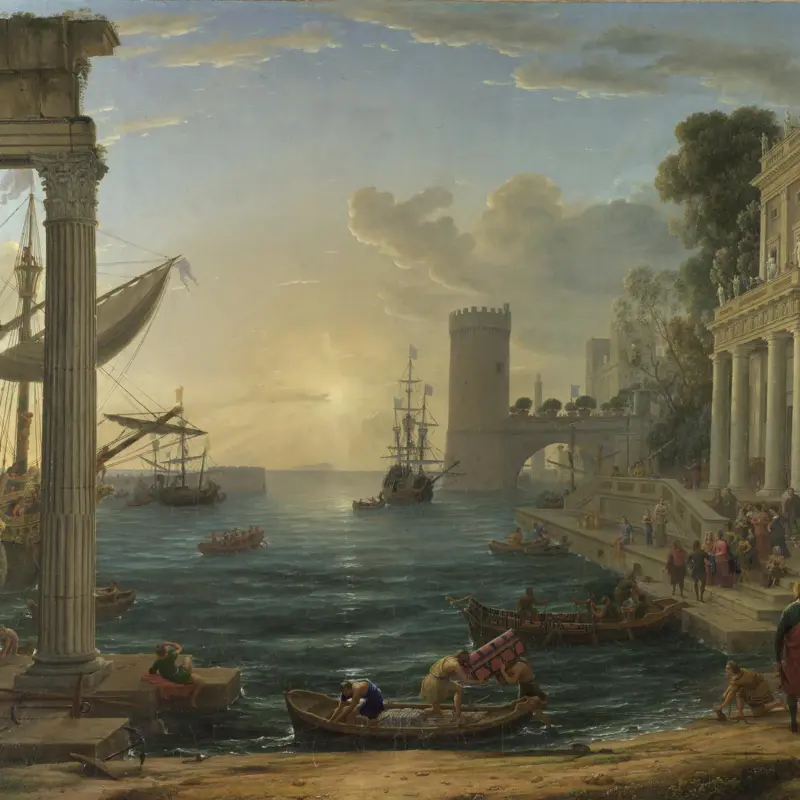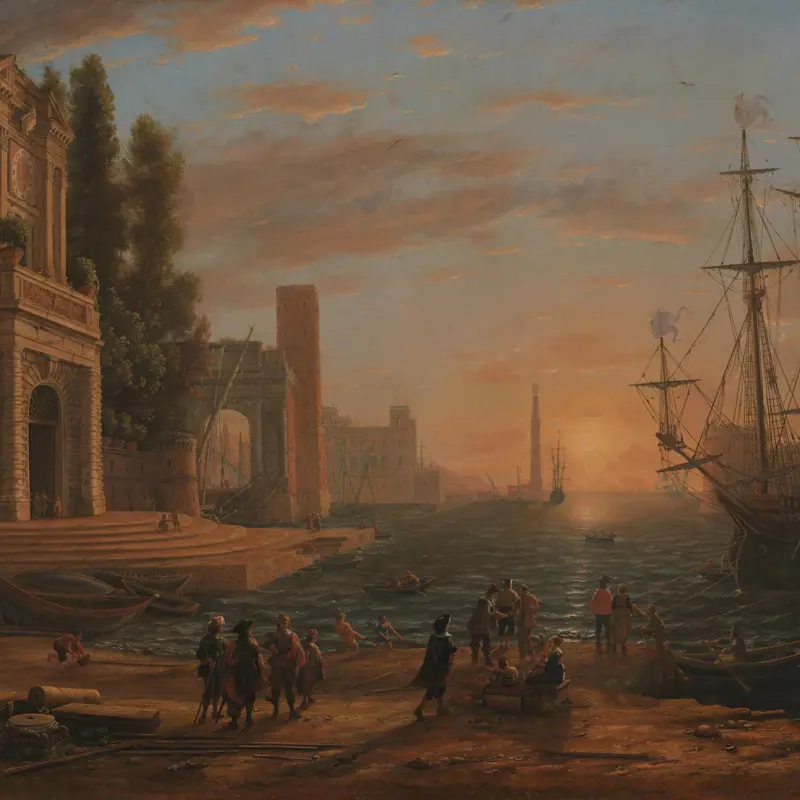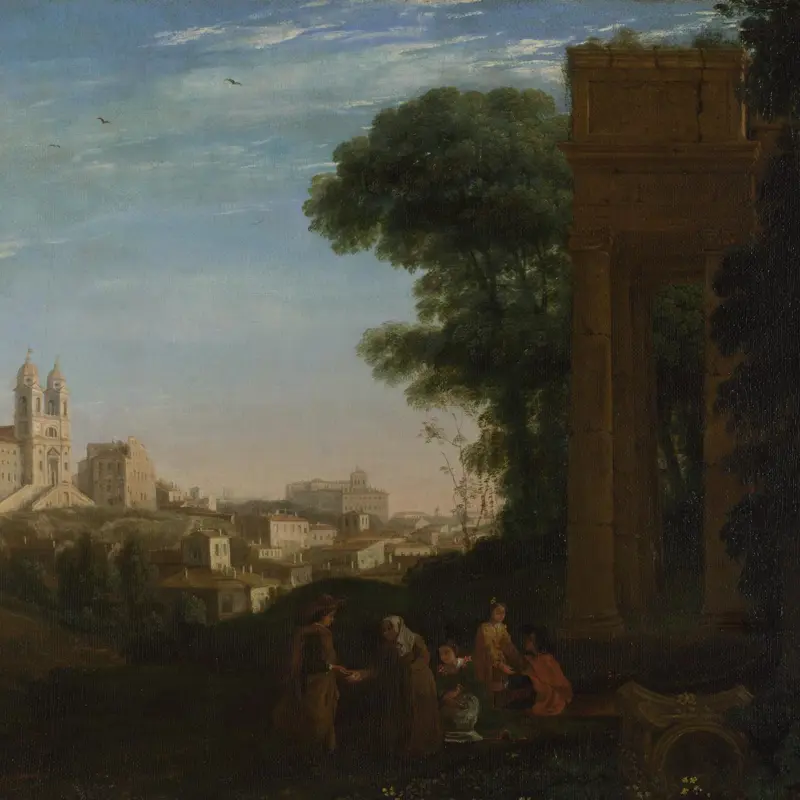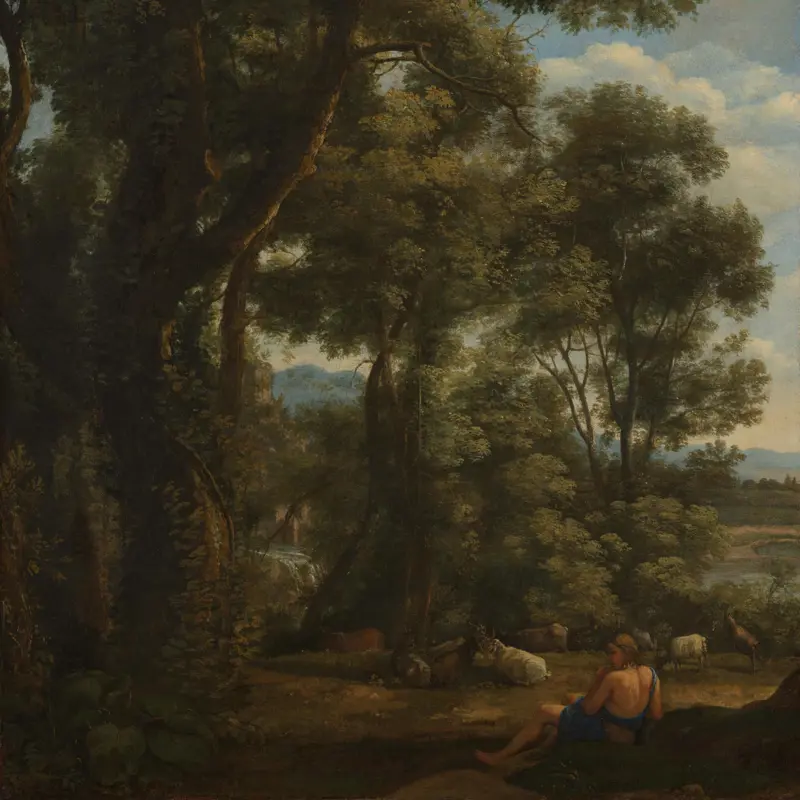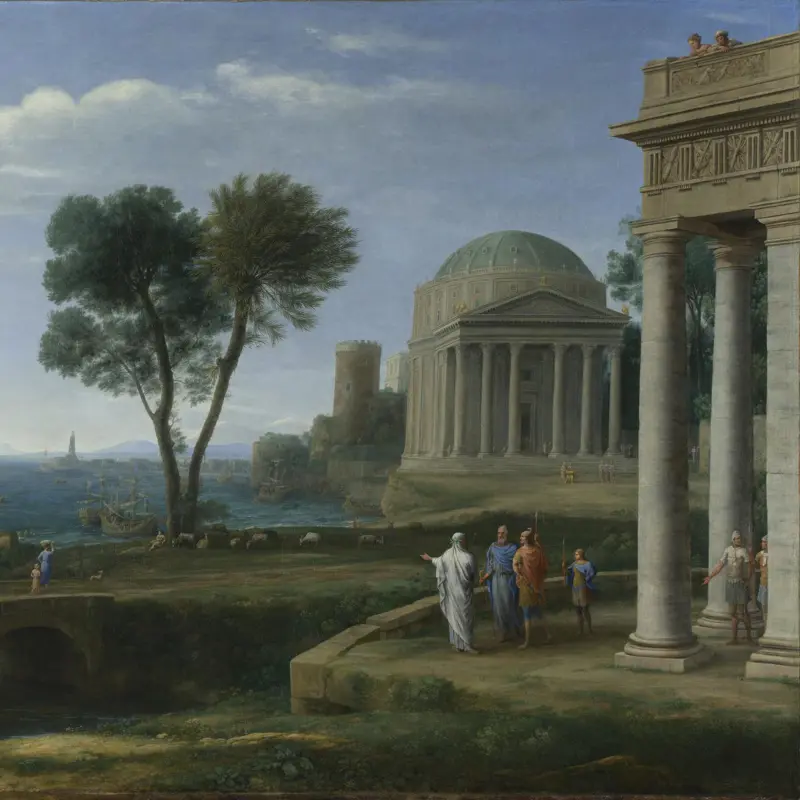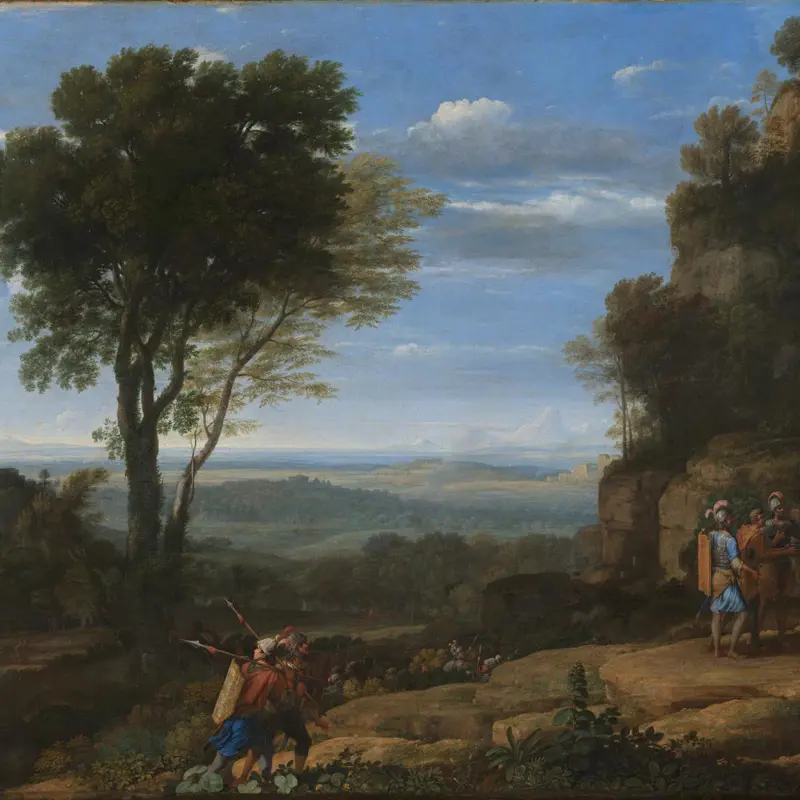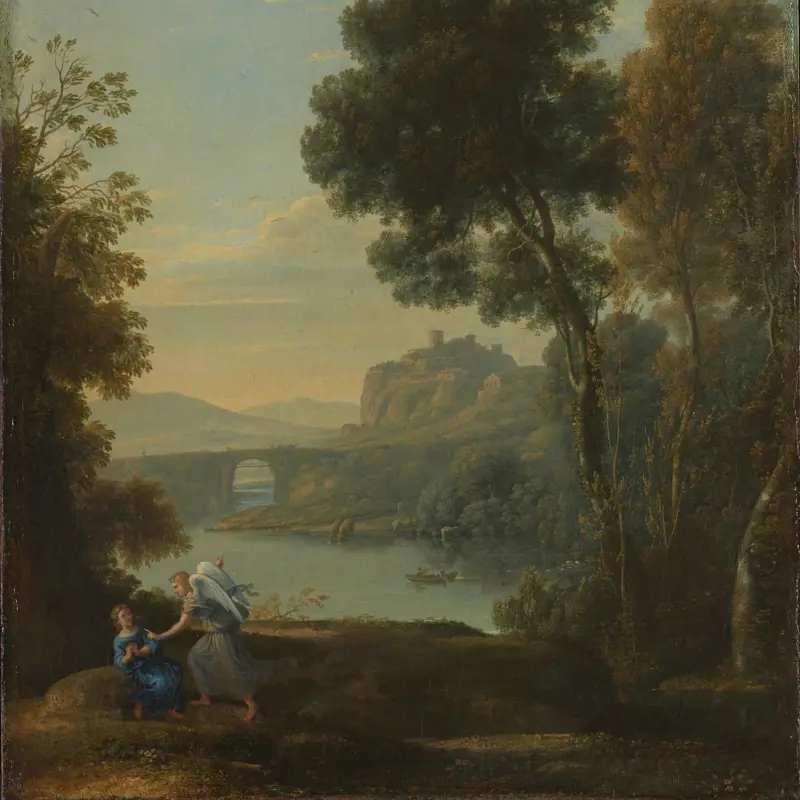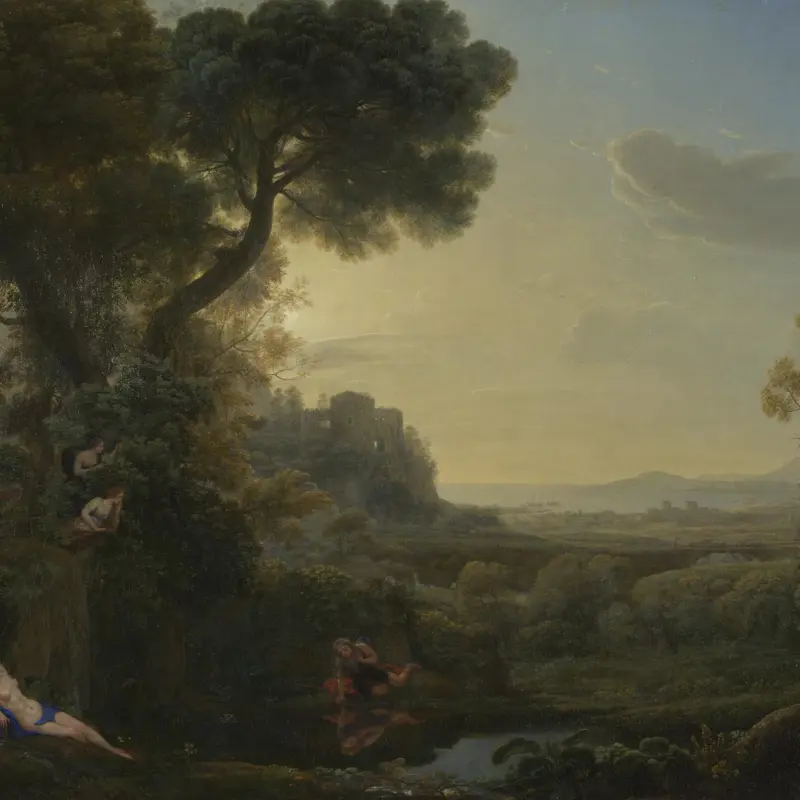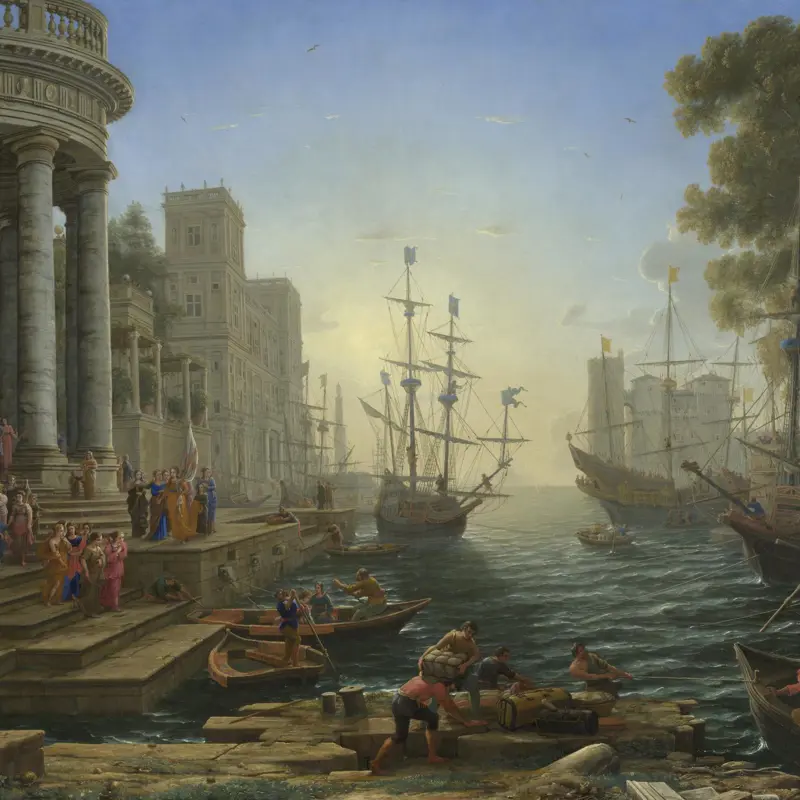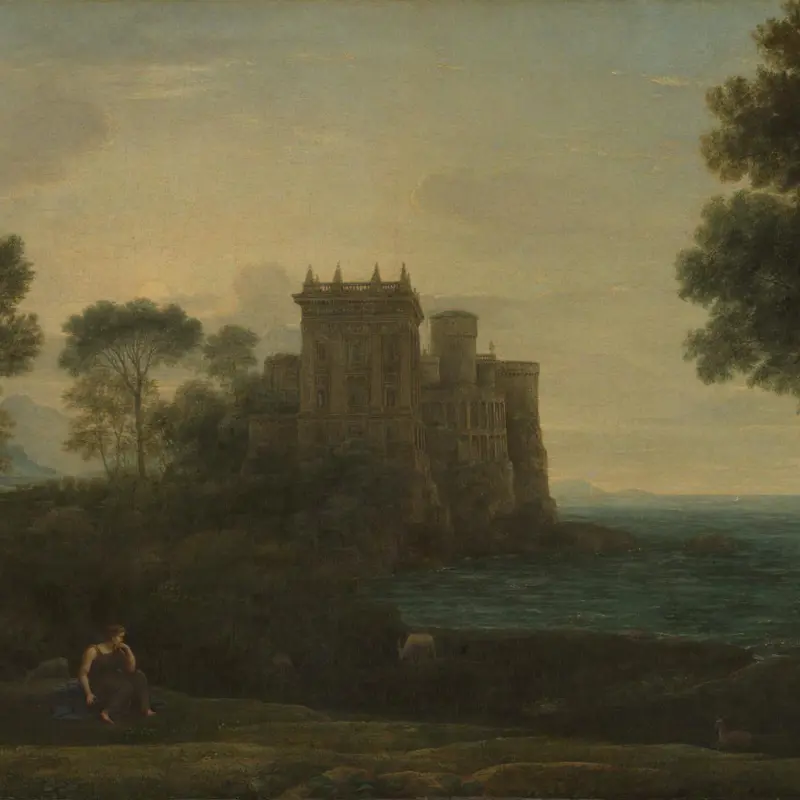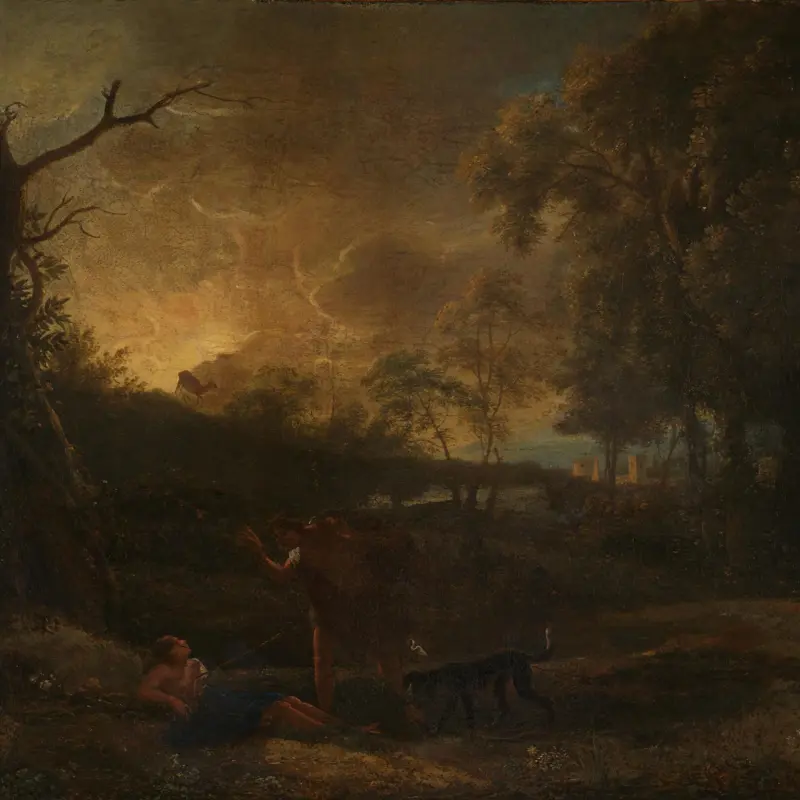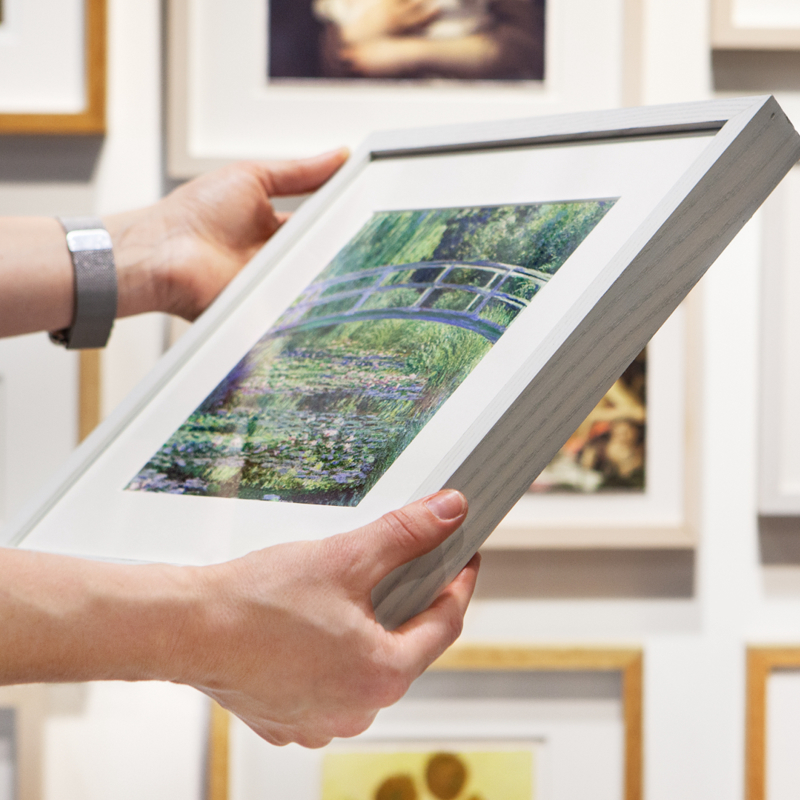Claude, 'The Mill', 1648
About the work
Overview
According to an inscription on a tree stump in the centre, this painting shows the marriage of Isaac and Rebecca described in the Old Testament book of Genesis. The couple dance with tambourines, surrounded by other figures reclining and enjoying the festivities. The flat landscape and expanse of water stretching far into the distance are imaginary, but inspired by the countryside around Rome, where Claude spent most of his life. Claude’s landscapes often included a mill and town in the background, under a naturalistic sky. Although a tower is also a common feature, this was the emblem of painting’s original owner, the duc de Bouillon (1605–1652).
This work and its pair Seaport with the Embarkation of the Queen of Sheba, painted in 1648, were among the first paintings to be bought for the National Gallery in 1824.
Key facts
Details
- Full title
- Landscape with the Marriage of Isaac and Rebekah ('The Mill')
- Artist
- Claude
- Artist dates
- 1604/5? - 1682
- Part of the series
- The Bouillon Claudes
- Date made
- 1648
- Medium and support
- Oil on canvas
- Dimensions
- 152.3 × 200.6 cm
- Inscription summary
- Signed; Dated and inscribed
- Acquisition credit
- Bought, 1824
- Inventory number
- NG12
- Location
- Room 36
- Collection
- Main Collection
- Previous owners
- Frame
- 18th-century French Frame
Provenance
Additional information
Text extracted from the ‘Provenance’ section of the catalogue entry in Humphrey Wine, ‘National Gallery Catalogues: The Seventeenth Century French Paintings’, London 2001; for further information, see the full catalogue entry.
Exhibition history
-
2012Turner Inspired: In the Light of ClaudeThe National Gallery (London)14 March 2012 - 5 June 2012
Bibliography
-
1745A.-J. Dézallier d'Argenville, Abrégé de la vie des plus fameux peintres, Paris 1745
-
1764A.-L. de La Live de Jully, Catalogue historique du cabinet de peinture et de sculpture françoise, de M. de La Live, Paris 1764
-
1787L. Thiéry, Guide des amateur et des étrangers voyageurs à Paris, ou description raisonnée de cette ville, de sa banlieue, & de tout ce qu'elles contiennent de remarquable, vol. 1, Paris 1787
-
1823J. Young, A Catalogue of the Celebrated Collection of Pictures of the Late John Julius Angerstein, Esq: Containing a Finished Etching of Every Picture, and Accompanied with Historical and Biographical Notices, London 1823
-
1824W. Buchanan, Memoirs of Painting: With a Chronological History of the Importation of Pictures by the Great Masters into England Since the French Revolution, London 1824
-
1829
J. Smith, A Catalogue Raisonné of the Works of the Most Eminent Dutch, Flemish, and French Painters: In Which is Included a Short Biographical Notice of the Artists, with a Copious Description of Their Principal Pictures […], 9 vols, London 1829-1842
-
1843C.-J. Nieuwenhuys, Description de la galerie des tableaux de S. M. le Roi des Pays-Bas, Brussels 1843
-
1884Mme Pattison, Claude Lorrain, sa vie et ses oeuvres, Paris 1884
-
1903J. Ruskin, Modern Painters, eds E.T. Cook and A. Wedderburn, The Works of John Ruskin, 39 vols, London 1903
-
1946Martin Davies, National Gallery Catalogues: French School, London 1946
-
1957Martin Davies, National Gallery Catalogues: French School, 2nd edn (revised), London 1957
-
1958M. Imdahl, 'Baumstellung und Raumwirkung. Zu verwandten Landschaftsbildern von Domenichino, Claude Lorrain und Jan Frans von Bloemen', in Festschrift Martin Wackernagel zum 75.Geburtstag, Cologne 1958, pp. 153-84
-
1961M. Röthlisberger, Claude Lorrain: The Paintings, London 1961
-
1975M. Röthlisberger, L'opera completa di Claude Lorrain, Milan 1975
-
1978A. Macintyre and K. Garlick (eds), The Diary of Joseph Farington, vol. 5, New Haven 1978-1984
-
1978M. Kitson, Claude Lorrain: Liber Veritatis, London 1978
-
1980J. Mills and R. White, 'Analyses of Paint Media', National Gallery Technical Bulletin, IV, 1980, pp. 65-7
-
1980M. Wyld, J. Mills and J. Plesters, 'Some Observations on Blanching (with Special Reference to the Paintings of Claude)', National Gallery Technical Bulletin, IV, 1980, pp. 49-63
-
1982H.D. Russell, Claude Lorrain 1600-1682 (exh. cat. National Gallery of Art, Washington, 17 October 1982 - 2 February 1983), Washington 1982
-
1984M. Röthlisberger, 'Claude Lorrain: Some New Perspectives: Claude Lorrain 1600-1682', Studies in the History of Art, XIV, 1984, pp. 47-65
-
1984C. Whitfield, 'Claude and a Bolognese Revival. Claude Lorrain 1600-1682', Studies in the History of Art, XIV, 1984, pp. 83-91
-
1988F.E. Wissman et al., Jean-Baptiste-Camille Corot: View of Volterra (exh. cat. Timken Art Gallery, 8 May - 26 June 1988; Sterling and Francine Clark Art Institute, 15 July - 11 September 1988), San Diego 1988
-
1989H. Langdon, Claude Lorrain, Oxford 1989
-
1991M. Clarke, Corot and the Art of Landscape, London 1991
-
1994A. Schnapper and M.-J. Massat, 'Un amateur de Poussin: Michel Passart (1611/1912- 1692)', Bulletin de la Société de l'Histoire de l'Art Français, 1994, pp. 99-109
-
1994H. Wine, Claude: The Poetic Landscape (exh. cat. The National Gallery, London, 26 January - 10 April 1994), London 1994
-
1997M.D. Rincón de Arellano, 'Turner visto por sus contemporáneos', Goya, 256, 1997, pp. 235-40
-
1999G. Bergmann, Claude Lorrain: Das Leuchten der Landschaft, München 1999
-
1999C. Stefani, 'Poussin, Lorrain, Dughet e Salvator Rosa: Ricezione e fortuna del paesaggio classico tra Sette e Ottocento', Studi di storia dell'arte, X, 1999, pp. 201-30
-
2000M. Kitson, Studies on Claude and Poussin, London 2000
-
2001
C. Baker and T. Henry, The National Gallery: Complete Illustrated Catalogue, London 2001
-
2001H. Wine, National Gallery Catalogues: The Seventeenth Century French Paintings, London 2001
-
2001C. Powell, 'Pure as Italian Air: Turner and Claude Lorrain', Turner Society News, 87, 2001, pp. 14-5
-
2002J. Pomeroy, 'The Arbiters of Taste: Artists as Advisors in Early Nineteenth-Century England', Gazette des beaux-arts, CXXXIX/1597, 2002, pp. 263-72
-
2003C. Pace, 'Collecting French Seventeenth-Century Paintings for the Nation', Art History, XXVI/2, 2003, pp. 281-315
-
2004A. Staley and C. Newall, Pre-Raphaelite Vision: Truth to Nature (exh. cat. Tate Britain, 12 February - 3 May 2004; Altes Nationalgalerie, 12 June - 19 September 2004; Fundació la Caixa, 6 October 2004 - 9 January 2005), London 2004
About this record
If you know more about this work or have spotted an error, please contact us. Please note that exhibition histories are listed from 2009 onwards. Bibliographies may not be complete; more comprehensive information is available in the National Gallery Library.
Images
About the series: The Bouillon Claudes
Overview
Two paintings by Claude, Seaport with the Embarkation of the Queen of Sheba and Landscape with the Marriage of Isaac and Rebecca, are known as the ‘Bouillon Claudes’ because they were made for Frédéric-Maurice, Duc de Bouillon (1605–1652), a French general in the papal army in Rome. They were completed in 1648 and remained in the Bouillon family throughout the eighteenth century. They even escaped seizure during the French Revolution, despite Bouillon’s successor being imprisoned in 1794 and his property confiscated.
Although documents survive to tell us these paintings were commissioned as a pair, the scenes belong to different biblical stories. They are, however, harmonious in the subjects they depict. Each explores the relationship between men and women, whether during a wedding celebration or because of a journey that brings friendship. There is a contrast between the bustling urban seaport and the peaceful countryside. The central activity of each painting is framed by either buildings or trees, with the sea or a substantial river in the background.



